Desde "Jailhouse Rock" hasta "Love Me Tender", las canciones de Elvis Presley se han convertido en una parte integral de la cultura estadounidense. Se tocan en fiestas, bodas y graduaciones, y se pueden escuchar de fondo en supermercados y centros comerciales. El catálogo de canciones contiene una variedad impresionante:algunas fueron compuestas para películas de verano divertidas pero olvidables, mientras que otras tienen sus raíces en las óperas italianas; algunos cuentan historias de amor sincero, mientras que otros simplemente están hechos para bailar. Todos fueron interpretados y grabados por uno de los artistas más exitosos que jamás haya visto la música popular estadounidense.
Galería de imágenes de Elvis Presley
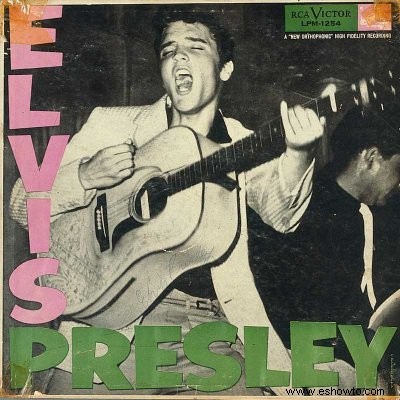
Elvis Presley fue uno de los artistas más exitosos en la historia de la música popular estadounidense. Ver más fotos de Elvis.
En las siguientes páginas, encontrará las historias detrás de algunas de las melodías más célebres de Elvis. Hay aspectos destacados de su carrera temprana, como "Baby Let's Play House", en la que Presley encontró por primera vez su característico sonido "rockabilly", la fusión de country y R&B que lo haría famoso. Estas primeras canciones se grabaron en el sello de Sam Phillips con sede en Memphis, Sun Records, y se consideran esenciales para escuchar entre los fanáticos del blues, el R&B y la música country por igual.
A continuación- Cuestionario de Elvis
- Las 30 mejores canciones de Elvis Presley
También aprenderá sobre los grandes éxitos que convirtieron a Elvis en un nombre familiar:"Heartbreak Hotel", el primer sencillo de Elvis en el sello discográfico RCA, se convirtió en un éxito número uno, pero originalmente se inspiró en una trágica muerte en Miami. "Hound Dog" creó oportunidades para numerosas apariciones televisivas irónicas (en el Steve Allen Show , Presley interpretó con buen humor la canción para un basset hound). Cuando se combinó con "Don't Be Cruel" en el lado B, el disco "Hound Dog" se convirtió en uno de los sencillos más exitosos que la industria de la música había visto hasta ahora. "Now or Never", una reelaboración rock and roll de una melodía clásica de ópera italiana, muestra a Presley interactuando con antiguas tradiciones y haciéndolas suyas.
Muchos críticos sienten que las primeras canciones de Presley se encuentran entre las mejores; pero los esfuerzos posteriores revelan una fascinante intersección entre la música y la fama de rápido crecimiento de Elvis. "If I Can Dream", grabado en 1968, mostraba a Presley en el centro de una nación en problemas. La canción, escrita por W. Earl Brown, el director musical de Elvis, fue diseñada como una respuesta sombría pero esperanzadora a los recientes asesinatos de Robert Kennedy y Martin Luther King, Jr. En ese momento, Presley tenía su propio especial de Navidad en televisión (llamado simplemente Elvis ) y, tras una velada de estándares festivos, "If I Can Dream" cerró el programa con un toque personal y conmovedor.
En las últimas páginas de este artículo, encontrará algunas listas de "lo mejor de" que pueden ayudar a cualquier novato de Elvis a navegar por su intimidante catálogo de canciones. Aprenderá más sobre algunos de los compositores de Presley, muchos de los cuales fueron artistas consumados por derecho propio, y también encontrará información sobre algunas de las versiones más famosas de Elvis. La sección final del artículo contiene una lista completa del trabajo grabado de Elvis Presley, ordenado alfabéticamente para facilitar la navegación.
Pase a la página siguiente para leer sobre uno de los temas de canciones más populares de Elvis:enamorarse (y desenamorarse).
Para obtener más información sobre Elvis Presley, consulte:
- Elvis Presley
- Imágenes de Elvis Presley
- Citas de Elvis Presley
- Coleccionables de Elvis Presley
- Biografía de Elvis Presley
- Las mejores canciones de amor de Elvis Presley
- Está bien
- Bebé, juguemos a las casitas
- Hotel rompecorazones
- Perro de caza
- No seas cruel
- Todos Conmocionados
- Roca de la cárcel
- Es ahora o nunca
- No puedo evitar enamorarme
- Si puedo soñar
- Mentes sospechosas
- Amor ardiente
- Las mejores versiones de canciones de Elvis Presley
- Los mejores compositores de canciones de Elvis Presley
- Lista de canciones de Elvis A - F
- Lista de canciones de Elvis G - I
- Lista de canciones de Elvis J - P
- Lista de canciones de Elvis Q - T
- Lista de canciones de Elvis U - Z
Las mejores canciones de amor de Elvis Presley
Las canciones de amor de Elvis Presley son algunas de las más famosas de su carrera. Presley grabó "I Want You, I Need You, I Love You", escrita por Maurice Mysels e Ira Kosloff, en
Jerry Leiber y Mike Stoller compusieron la llamativa "Love Me" en 1954 como una parodia de las baladas country. El 1 de septiembre de 1956, Elvis la grabó sin rodeos y con sentimiento, convirtiéndola en una seria canción de amor.
Elvis grabó "Love Me Tender" en
George Weiss, Hugo Peretti y Luigi Creatore escribieron "Can't Help Falling in Love" para Blue Hawaii . Elvis lo grabó en
Elvis grabó "It Hurts Me" en
"Until It's Time for You to Go" fue escrita y grabada originalmente por Buffy Sainte-Marie en 1965 y fue lanzada por varios artistas antes que Elvis. Otros que lo grabaron incluyeron a Michael Nesmith (como Michael Blessing), Four Pennies y Neil Diamond. Elvis grabó esta hermosa canción de amor en
Grabado el 27 de marzo de 1972, "
Mark James, Wayne Carson y Johnny Christopher compusieron "Always on My Mind" especialmente para Elvis, aunque otros cantantes han tenido éxito con ella. . Elvis fue el primero en grabarlo, el 29 de marzo de 1972, pero primero se lanzó la versión de Brenda Lee. En 1982, Willie Nelson obtuvo un éxito country número uno con él, mientras que los Pet Shop Boys grabaron una versión en 1988.
Elvis grabó "It's Midnight" en el legendario Stax Records en
La versión más conocida de "Unchained Melody" fue lanzada por Righteous Brothers en 1965, aunque fue escrita en 1955 para la película Desencadenado . Varios artistas lo grabaron en la década de 1950, incluidos Les Baxter, Roy Hamilton, Al Hibbler y June Valli. Elvis cantó esta sincera canción de amor en un concierto durante la década de 1970 y la grabó interpretándola en vivo en
"Ámame con ternura"
Elvis fue acreditado como coautor de esta balada de amor, aunque en realidad fue compuesta por Ken Darby, quien se desempeñó como supervisor vocal de la película. La esposa de Darby, Vera Matson, también recibió crédito. La canción se basó en una balada de la era de la Guerra Civil llamada "Aura Lee" (a veces deletreada "Aura Lea"), que fue escrita por WW Fosdick y George R. Poulton. "Aura Lee" se convirtió en un favorito del Ejército de la Unión.
Casi 100 años después, la canción volvió a ser una de las favoritas del público, esta vez reencarnada como "Love Me Tender" de Elvis. El lanzamiento del sencillo de la canción de Elvis logró una primicia en la historia de la música cuando recibió ventas anticipadas de más de 1 millón de copias. La versión cinematográfica de la canción tenía letras ligeramente diferentes y contenía un verso adicional. Elvis siempre había admirado a los cantantes pop como Dean Martin, y "Love Me Tender" le dio la oportunidad de influir en sus suaves tonos.
Para obtener más información sobre Elvis Presley, consulte:
- Elvis Presley
- Imágenes de Elvis Presley
- Citas de Elvis Presley
- Coleccionables de Elvis Presley
- Biografía de Elvis Presley
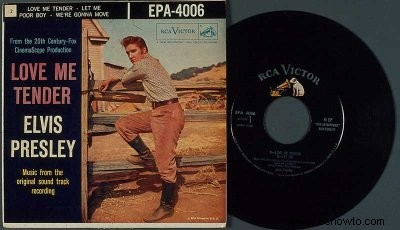
"Love Me Tender" se basó en una balada de la era de la Guerra Civil llamada " Aura Lee".
Está bien
La primera grabación de Elvis Presley para Sun Records, "That's All Right", pareció surgir casi por accidente. Cuando el propietario y operador de Sun, Sam Phillips, necesitaba un cantante para grabar una balada llamada "Without You", recordó a un niño llamado Elvis Presley. Elvis había grabado un par de acetatos en el Servicio de Grabación de Phillips en Memphis, y la asistente de Phillips, Marion Keisker, lo había grabado para futuras referencias. Phillips decidió dejar que Elvis grabara "Without You", pero el cantante sin experiencia no pudo dominar la nueva canción.
Elvis cantó varias otras canciones para Phillips, quien quedó lo suficientemente impresionado como para juntarlo con el guitarrista Scotty Moore para darle un poco de condimento. Moore, Elvis y el bajista Bill Black estaban trabajando juntos en Sun la noche del 5 de julio de 1954, tratando de encontrar un sonido que encajara. Nada parecía estar funcionando. Durante un descanso, Elvis comenzó a jugar con la melodía country blues de Arthur "Big Boy" Crudup, "That's All Right", cantándola con un estilo acelerado, casi informal. Cuando Moore y Black saltaron, la voz de Phillips resonó desde la cabina de control:"¿Qué estás haciendo?".
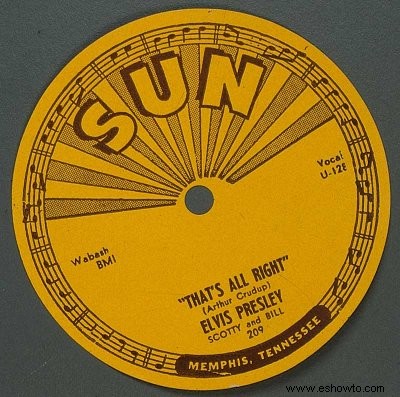
“Eso está bien”, fue la primera grabación de Elvis Presley para Sun Records. Aunque
no llegó a las listas de éxitos, envió a Elvis en su camino para convertirse en una leyenda de la grabación.
Phillips estaba entusiasmado con el sonido del trío y reconoció su potencial. Grabó "That's All Right" esa noche y unos días después lo acompañó con el clásico bluegrass "Blue Moon of Kentucky". El enfoque de Elvis para ambas canciones difería de los originales. Usó un estilo vocal más relajado y una clave más alta para "Eso está bien" que Crudup. Aceleró el tempo de "Blue Moon of Kentucky" y omitió el estilo de canto bluegrass agudo. Se agregaron dos elementos a ambas canciones que harían famoso a Elvis:la síncopa y un efecto de eco "slapback" (retardado electrónicamente). El estilo Sun de Elvis se convirtió en el epítome del rockabilly.
"That's All Right" recibió una difusión extendida en el programa de radio Red Hot and Blue de Dewey Phillips en WHBQ, y se lanzó como sencillo el 19 de julio de 1954. El sencillo no llegó a las listas nacionales, pero lanzó la carrera discográfica de la mayoría. famoso cantante del siglo XX.
Sam Phillips, el productor de "Eso está bien"
Nacido y criado en las afueras de Florence, Alabama, en 1923, Sam Cornelius Phillips estuvo muy influenciado por sus raíces sureñas rurales. Trabajando en los campos de algodón con afroamericanos, Phillips estuvo expuesto a la música gospel y blues, y experimentó la pobreza y la vida dura de muchas familias sureñas de la era de la Depresión. Como productor discográfico, aprovecharía esas experiencias para dar forma a una nueva estética musical:un sonido puramente sureño que combinaba el rhythm and blues negro y el country-western blanco con una filosofía dura nacida de los malos tiempos. La nueva música que surgió, un sonido estilo Dixie llamado rockabilly, emanaría de Sun Records de Phillips a mediados de la década de 1950 e influiría en todo el rock 'n' roll.
El genio de Phillips fue reconocer a cantantes y músicos talentosos, en blanco y negro, que pudieran transmitir la estética que él imaginó. Sobre su deseo de grabar música basada en el sur, Phillips reflexionó:"Sabía que esto era cultura, y estaba tan arraigado en esta gente debido a las dificultades... Generación tras generación, estas personas [del sur] han sido pasadas por alto:negros y ¡blanco!" Por sus contribuciones en la formación de la música moderna, Phillips fue uno de los primeros en ser incluido en el Salón de la Fama del Rock 'n' Roll.
Para obtener más información sobre Elvis Presley, consulte:
- Elvis Presley
- Imágenes de Elvis Presley
- Citas de Elvis Presley
- Coleccionables de Elvis Presley
- Biografía de Elvis Presley
Bebé, juguemos a las casitas
"Baby Let's Play House", el cuarto sencillo de Elvis Presley para Sun Records, grabado el 5 de febrero de 1955, fue el esfuerzo de Presley por ubicarse en las listas nacionales. Respaldada por "I'm Left, You're Right, She's Gone" en el otro lado, la canción permaneció en la lista de países de Billboard durante diez semanas, alcanzando el número diez.
El cantante de ritmo y blues Arthur Gunter había escrito y grabado la canción en 1954, basándose en el éxito de 1951 del cantante de country Eddy Arnold, "I Want para jugar a la casita contigo". Siendo una reelaboración de ritmo y blues de una canción country-western, "Baby Let's Play House" fue perfecta para el repertorio rockabilly de Elvis. El propio Gunter había sido influenciado por artistas de rockabilly, y fue un buen modelo para Elvis, quien había comprado una copia de la versión de Gunter el diciembre anterior en House of Records en
Elvis hizo suya la canción con la inclusión de la frase sincopada "babe-babe-baby" en el verso. También jugó con la letra, cambiando "Puedes tener religión" por "Puedes conducir un Cadillac rosa", una predicción humorística del automóvil con el que llegaría a ser identificado.
Sam Phillips agregó la batería a la sesión de grabación de la canción, marcando la primera vez que se usaron baterías en un sencillo de Presley. A medida que la canción recibió exposición nacional, se la llamó canción country en las publicaciones comerciales, y pocos la relacionaron con el relativamente desconocido artista de rhythm and blues que había inspirado a Elvis.
Elvis agregó "Baby Let's Play House" y "I'm Left, You're Right, She's Gone" a su actuación en la primavera de 1955. Por esta época, su popularidad aumentaba rápidamente debido a sus apariciones en el programa de radio Louisiana Hayride y a sus giras por el sur con espectáculos country-western cada vez más grandes. Elvis cantó "Baby Let's Play House" en su segunda aparición en Stage Show el 4 de febrero de 1956, justo cuando su sensual estilo de interpretación comenzaba a crear una controversia nacional.
Si su actuación de balanceo de cadera en Stage Show llamó la atención, entonces la letra de "Baby Let's Play House" se sumó a la connotación provocativa. Básicamente, una proposición, la canción es una súplica del cantante a su novia para que regrese con él porque quiere "jugar a la casita" con ella, un término del argot para una pareja no casada que vive o duerme junta. A pesar de la súplica del cantante, él adopta una postura de confrontación. , diciéndole a su chica:"Prefiero verte muerta que con otro hombre".
Registros de Sun
Aparte de
Phillips había estado grabando artistas de blues como Howlin' Wolf, BB King, Little Walter, Ike Turner, Little Junior Parker y Bobby Blue Bland desde 1950, pero alquiló esas grabaciones a otros sellos, incluidos Chess Records y RPM Records. Hasta que se estableció Sun, no había un lugar importante en el Sur para que los artistas grabaran. Después de que Phillips estableciera Sun, pudo lanzar a sus artistas en su propio sello.
Muchos saben que el legendario productor grabó a artistas de blues y R&B, pero menos familiares son los cantantes de country que comenzó a grabar en 1953. Empezó con Ripley Cotton Choppers, luego pasó a Doug Poindexter, Slim Rhodes y Warren Smith.
Después de que Elvis experimentara el éxito en el sello Sun, otros que se convertirían en leyendas del rockabilly firmaron con Phillips, incluidos Jerry Lee Lewis, Carl Perkins, Johnny Cash, Roy Orbison, Charlie Rich, Conway Twitty y Charlie Feathers. Phillips vendió Sun en 1969.
Para obtener más información sobre Elvis Presley, consulte:
- Elvis Presley
- Imágenes de Elvis Presley
- Citas de Elvis Presley
- Coleccionables de Elvis Presley
- Biografía de Elvis Presley
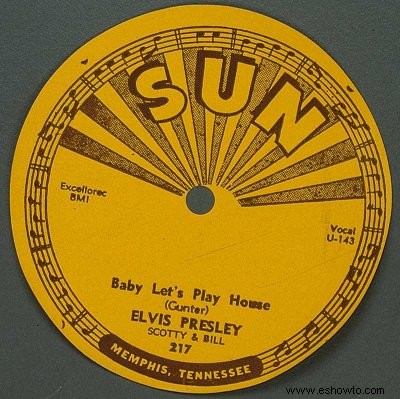
La grabación de Presley de 1955 de "Baby Let's Play House" permaneció en Billboard
Top Ten durante diez semanas.
Hotel de los corazones rotos
Los orígenes del éxito de Elvis Presley "Heartbreak Hotel" se encuentran en Miami. "Camino por una calle solitaria". Así lee la nota de suicidio de un alma anónima que acabó con su vida en
En
Axton una vez había trabajado para el coronel Tom Parker y sugirió que escribieran la canción para Elvis Presley. Según cuenta la historia, una vez le había dicho a Elvis que iba a escribir su primer vendedor millonario. Después de que Mae decidiera que "abajo al final de
Glen Reeves, un cantante local, grabó un disco de demostración de la canción en un estilo que sugería a Elvis Presley. Axton voló a
"Heartbreak Hotel" se convirtió en el primer disco que Elvis lanzó en su nuevo sello, RCA. En diciembre de 1955, RCA había reeditado "Mystery Train" de Elvis, lanzado originalmente en el sello Sun, pero la reedición no se vendió particularmente bien. Elvis ingresó a
Axton le había pedido a Reeves que emulara el estilo de Elvis en la demostración, y Elvis copió las entonaciones vocales de Reeves para su grabación. Esta historia muestra que el estilo de Elvis era lo suficientemente familiar como para ser reconocido como suyo en ese momento. También ilustra el patrón de Elvis al grabar una demostración. Copiaba la interpretación del cantante de demostración cada vez que grababa su versión de una canción.
En Sun Records, Elvis había sido respaldado por Sentry Moore en la guitarra y Bill Black en el bajo. Más tarde se agregó un baterista, un puesto que finalmente ocupó D.J. Fontana de forma permanente. En RCA, al combo de Elvis se unieron Chet Atkins en la guitarra rítmica y Floyd Cramer en el piano, junto con un trío de gospel formado por Ben y Brock Speer de la familia Speer y Gordon Stoker de los Jordanaires.
"Heartbreak Hotel" tomó prestado el sonido de eco que se asoció con los lanzamientos de Sun de Elvis, tal vez incluso exagerándolo. El efecto es inquietante, francamente fantasmal, particularmente durante las primeras líneas de cada verso cuando Elvis canta sin acompañamiento. Su voz es penetrante y el sonido es abatido, capturando perfectamente la alienación de la juventud descontenta.
La canción fue lanzada como sencillo el 27 de enero de 1956, respaldada por "I Was the One". Al día siguiente, Elvis apareció en la serie de variedades de televisión de Tommy y Jimmy Dorsey, Stage Show. , pero no cantó "Heartbreak Hotel" hasta su tercera aparición en el programa, el 11 de febrero. La cantó en dos Stage Show posteriores. apariciones y en su primera aparición en The Milton Berle Show el 3 de abril.
La exposición televisiva sin duda ayudó a impulsar la canción al puesto número uno en las listas de éxitos de ventas y juke box de Billboard, donde permaneció durante ocho semanas. . La canción también alcanzó el número uno en la lista de países y el número tres en la lista de R&B. Se convirtió en el primer vendedor de un millón de Elvis, tal como había predicho Axton.
Mae, Ken y la Sra. Ed Wood
Elvis grabó cientos de canciones escritas por una variedad de compositores durante su carrera, por lo que no es sorprendente que algunos de esos compositores puedan caer bajo el título "peculiar." Mae Boren Axton, coautora de "Heartbreak Hotel", era una profesora de inglés que trabajaba en la periferia del mundo del espectáculo mientras vivía en
El compositor ganador del Premio de la Academia Ken Darby escribió y arregló "Love Me Tender" para la primera película de Elvis. Al principio de su carrera, Darby hizo una contribución única a la cultura cinematográfica estadounidense cuando cumplió con una tarea inusual para la película El mago de Oz. . Fue responsable de crear el sonido distintivo de las voces de los Munchkins.
Dolores Fuller coescribió 12 canciones para Elvis, incluidas "Rock-a-Hula Baby", "Do the Clam" y "Barefoot Ballad". Fuller era la esposa de Ed Wood, Jr., un ahora famoso director de películas de terror y explotación que trabajó al margen de la industria durante las décadas de 1950 y 1960. Apareció en su película de 1954 Jail Bait .
Para obtener más información sobre Elvis Presley, consulte:
- Elvis Presley
- Imágenes de Elvis Presley
- Citas de Elvis Presley
- Coleccionables de Elvis Presley
- Biografía de Elvis Presley
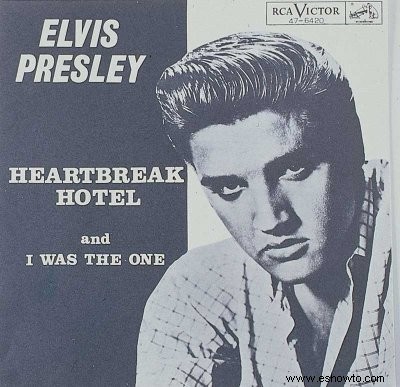
"Heartbreak Hotel" se inspiró en la nota de suicidio de un hombre que terminó su la vida
en un hotel de Miami.
Perro de caza
Después de que Elvis Presley sacudiera The Milton Berle Show con su interpretación trepidante de "Hound Dog", esta áspera melodía de R&B se vinculó de manera indeleble con su nombre. Sin embargo, no fue el primero en grabar una versión exitosa, ni cantó la letra original.
La canción fue escrita por Jerry Leiber y Mike Stoller en 1952 para el cantante de blues Willie Mae "Big Mama" Thornton a pedido de Johnny Otis, un bullicioso líder de banda, productor, compositor y DJ de R&B. Otis invitó al equipo a ver
Thornton gruñó la letra descarada con un ritmo de blues contundente, y "Hound Dog" vendió más de medio millón de copias, subió al número uno en las listas de R&B y se convirtió en el disco más vendido en el mercado de R&B durante 1953.
Varios artistas hicieron una versión de "Hound Dog", incluidos los artistas country Tommy Duncan, Betsy Gay, Jack Turner y Billy Start, y el acto de salón Freddie Bell and the Bellboys.
Parte de la razón por la que la versión de Elvis se hizo tan famosa se debió sin duda a la televisión. Elvis presentó la canción a una audiencia nacional en The Milton Berle Show el 5 de junio de 1956, y la atención que generó esa controvertida actuación resultó en una reserva en The Steve Allen Show , donde Elvis cantó animosamente la canción a un basset hound.
Cuando Elvis cantó "Hound Dog" en The Ed Sullivan Show , la canción se asoció con la controversia. Elvis bromeó con la audiencia del estudio de Sullivan, que estaba preparada para los fuegos artificiales del joven cantante, comenzando y luego deteniendo la canción después de la primera nota.
Un cantante masculino cantando a todo pulmón la primera línea de "Hound Dog" parece extraño porque la canción fue claramente escrita para una voz femenina, y la decisión de Elvis de agregar "Hound Dog" a su repertorio ha sido interpretada de diversas maneras por los historiadores de la música rock. Algunos insisten que Elvis debe haber estado familiarizado con el
Sin embargo, parece probable que Elvis conociera el historial de Thornton. Aunque la versión grabada de Elvis era una interpretación de rock 'n' roll siguiendo el modelo de
Presionado por el productor Steve Sholes para grabar la melodía, Elvis finalmente capturó "Hound Dog" después de unas 30 tomas en
Para obtener más información sobre Elvis Presley, consulte:
- Elvis Presley
- Imágenes de Elvis Presley
- Citas de Elvis Presley
- Coleccionables de Elvis Presley
- Biografía de Elvis Presley
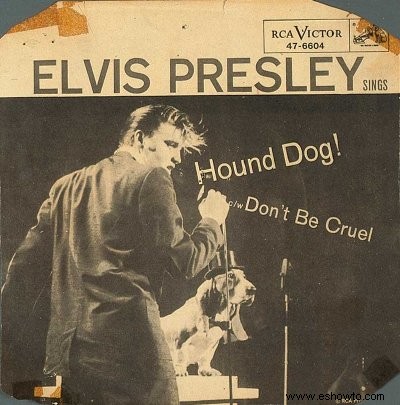
Aunque "Hound Dog" fue originalmente cantada por "Big Mama" Thornton, Elvis Las famosas
apariciones televisivas de Presley posteriormente vincularon su nombre con la melodía.
No seas cruel
"Hound Dog" y "Don't Be Cruel" de Elvis Presley se convirtieron en un éxito doble que subió al número uno y retuvo esa posición durante 11 semanas, más que cualquier otro lanzamiento sencillo de la era del rock 'n' roll. También alcanzó el número uno en las listas de country-western y rhythm and blues.
"Don't Be Cruel" fue escrita por el cantautor de ritmo y blues Otis Blackwell, aunque a Elvis se le dio crédito como coautor. Blackwell había vendido la canción a un editor de música, Shalimar Music, por $ 25 en la víspera de Navidad de 1955. El editor padre de Elvis, Hill and Range, había adquirido la canción, y la demostración era una de una pila que el nuevo cantante escuchó durante una sesión de grabación de RCA en julio de 1956.
Cuando Elvis quiso grabar la canción, le dijeron a Blackwell que tendría que llegar a un acuerdo y compartir el crédito del escritor con él, aunque Elvis no lo hizo. no contribuye en nada a escribir la canción. Blackwell estaba inquieto por el trato, pero se dio cuenta de que ganaría una gran cantidad de dinero con las regalías, incluso a mitad de interés, si Elvis grababa la canción. Esta no sería la última vez que Elvis recibe un crédito por escribir una canción que no compuso originalmente.
During the recording session, Elvis rehearsed the song a couple of times with his regular backup musicians, a piano player hired by RCA, and the Jordanaires. Then, the group worked on the song, finessing it as they went through almost 30 takes.
All the musicians contributed something in their own way. DJ. Fontana used Elvis' leather-covered guitar as a makeshift drum to capture a snare effect by laying it across his lap and hitting the back with a mallet. Their efforts resulted in one of Elvis' most beloved songs and one of his personal favorites. Total sales for any Presley single are often difficult to calculate, but by March 1992, "Don't Be Cruel"/"Hound Dog" had been awarded triple platinum status by the RIAA.
To learn more about Elvis Presley, see:
- Elvis Presley
- Elvis Presley Pictures
- Elvis Presley Quotes
- Elvis Presley Collectibles
- Elvis Presley Biography
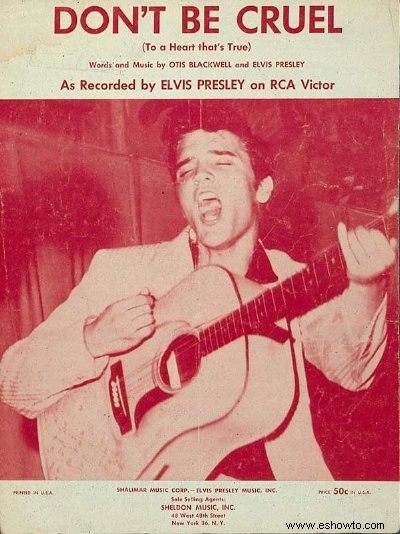
Elvis' "Don't Be Cruel", the B-side to the "Hound Dog" single, topped the charts
for 11 weeks straight.
All Shook Up
Otis Blackwell, who had written "Don't Be Cruel," also penned Elvis Presley’s number-one hit “All Shook Up." In retrospect, the tune tends to be overshadowed by Elvis' other major recordings from 1957, but "All Shook Up" racked up some interesting statistics in its time. The song remained at the top of Billboard's pop chart for nine weeks, and it stayed on the chart for 30 weeks -- the longest of any Elvis single. At year's end, "All Shook Up" was named the number-one single for 1957. Elvis also had the number-one single for 1956, "Heartbreak Hotel," making him the first singer of the rock era to top the year-end charts for two consecutive years.
Blackwell's inspiration for the title "All Shook Up" came from a mundane incident straight out of everyday life, though the story has undoubtedly been enhanced through repeated tellings. While working for Shalimar Music as a songwriter, Blackwell was sitting in the office trying to come up with a new powerhouse tune.
Contrary to some reports, Blackwell did not compose the tune specifically for Elvis as a follow-up to "Don't Be Cruel." Two other singers, David Hill and Vicki Young, recorded “All Shook Up" before him. Elvis recorded the tune in
Again, Blackwell reluctantly agreed to share a writing credit with Elvis, or else Elvis' management (including Colonel Parker and music publishers Hill and Range) would not have allowed him to record the tune.
To learn more about Elvis Presley, see:
- Elvis Presley
- Elvis Presley Pictures
- Elvis Presley Quotes
- Elvis Presley Collectibles
- Elvis Presley Biography
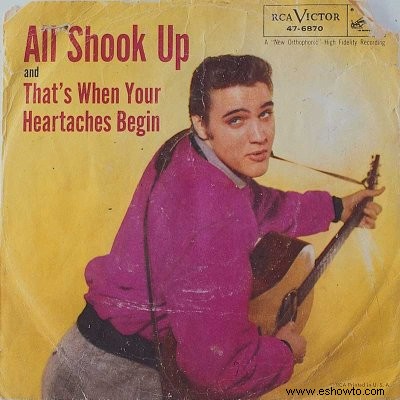
Legend has it that the inspiration for Elvis' "All Shook Up" came from a
foaming soda bottle.
Jailhouse Rock
"Jailhouse Rock," penned by the legendary Jerry Leiber and Mike Stoller, became another number-one record for Elvis Presley. It entered the British charts at number one, making it the first single ever to do so. The rock 'n' roll songwriting duo was commissioned to write most of the songs for the movie Jailhouse Rock , though they were less than enthusiastic about the assignment.
Prior to Jailhouse Rock Elvis had recorded a handful of songs from Leiber and Stoller, including "Hound Dog, "'Love Me," and a couple of tunes from Loving You . The two songwriters were not impressed with Elvis' interpretation of their material. Leiber and Stoller tended to write hard-driving, R&B-flavored runes with satiric or tongue-in-cheek lyrics that could be understood at more than one level.
Elvis, on the other hand, performed most of his material straight, as when he recorded the duo's "Love Me," which they had originally intended as a lampoon of country-western music. Leiber and Stoller also felt that Elvis' foray into R&B territory was a fluke, and they were suspicious of his interest in blues and rhythm and blues.
The three met during the April 1957 recording session for "Jailhouse Rock," and Leiber and Stoller quickly changed their minds about Elvis once they realized he knew his music and that he was a workhorse in the studio.
The pair took over the recording sessions, serving as unofficial producers of "Jailhouse Rock, "'Treat Me Nice," "(You're So Square) Baby, I Don't Care," and other tunes. Their collaboration with Elvis and his musicians on "Jailhouse Rock" resulted in the singer's hardest-rocking movie song. As D.J. Fontana once noted about his drum playing on the record, "I tried to think of someone on a chain gang smashing rocks."
The short period of time that Leiber and Stoller worked with Elvis proved beneficial to both sides. The irony and ambiguity in the lyrics of "Jailhouse Rock" gave Elvis one of his most clever rockers while the singer's sincere and energetic delivery prevented the song from becoming too much of a burlesque -- a tendency with some of Leiber and Stoller's songs written for the Coasters. The songwriters hung with Elvis long enough to contribute to the King Creole soundtrack, among other projects, but eventually they ran afoul of Elvis' management for trying to introduce him to new challenges.
To learn more about Elvis Presley, see:
- Elvis Presley
- Elvis Presley Pictures
- Elvis Presley Quotes
- Elvis Presley Collectibles
- Elvis Presley Biography
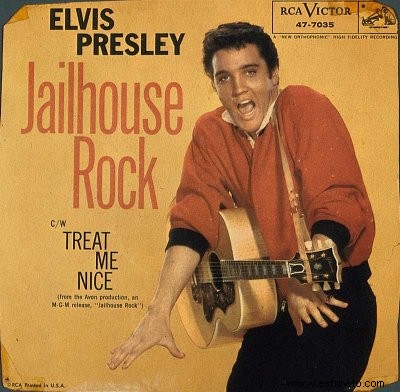
"Jailhouse Rock," penned by the legendary Leiber and Stoller, became the
first single ever to enter the British charts at number one.
It's Now or Never
Who could have guessed that "It's Now or Never," a reworked version of the 1901 Italian opera-style classic "O Sole Mio" with a cha-cha arrangement would become Elvis Presley's biggest-selling single? But then, in 1956, when Elvis was skewered by most newspapers in the country for thrusting his hips to the bluesy beat of "Hound Dog," no one would have guessed that he would become a press favorite in just four short years.
Elvis won the hearts and minds of the mainstream press and general public by quietly serving his country in the army. This helped soften his image as a dangerous rock 'n' roller. Further distancing himself from that image, Elvis began to move away from rock ‘n’ roll when he returned to recording in 1960. "It's Now or Never" was an important single release for Elvis in that regard. It received airplay on conservative radio stations that previously wouldn't have touched a Presley record, thus exposing Elvis to a wider, adult audience.
Yet Elvis did not record the song just to gain a broader audience. "O Sole Mio" was written by G. Capumo and Eduardo di Capua at the turn of the century, but it had been made popular much later by Mario Lanza.
Elvis was a fan of Lanza and undoubtedly heard the opera singer's recording, but he had also heard the English version of the song, "There's No Tomorrow" by Tony Martin. While still in the army, Elvis asked his music publisher, Freddie Bienstock of Hill and Range (a part of RCA), to find someone to write new lyrics for the song.
The only songwriters available at Hill and Range to do it were Aaron Schroeder and Wally Gold, who jumped at the chance because they knew the royalties on an Elvis Presley song would be enormous. They composed the lyrics in less than half an hour. A singer named David Hill (aka David Hess) recorded the demo with a cha-cha arrangement, and Elvis loved it. He was challenged by the operatic style, and he was attracted to the drama of it.
"It's Now or Never" charted for 20 weeks, holding the number-one slot for five weeks. Worldwide sales of the tune, according to The Guiness Book of Recorded Sound , eventually exceeded 20 million copies.
To learn more about Elvis Presley, see:
- Elvis Presley
- Elvis Presley Pictures
- Elvis Presley Quotes
- Elvis Presley Collectibles
- Elvis Presley Biography
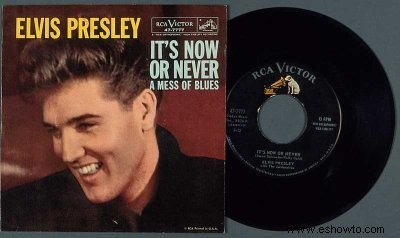
"It's Now or Never," a reworked version of the 1901 Italian opera-style "O Sole Mio,"
introduced Elvis to a wider, more "adult" audience.
Can't Help Falling in Love
"Can't Help Falling in Love," writtenspecifically for Blue Hawaii by George Weiss, Hugo Peretti, and Luigi Creatore,is remembered as the ballad Elvis Presley closedhis concerts with during the 1970s. In the film, Elvis' character sings it tothe grandmother of his girlfriend for her birthday, but that context has longsince been forgotten. Because Elvis sang it so many times in concert, it ismore fitting to suggest that the song belongs to the fans. It speaks to the waythe fans felt about Elvis, and it was his love song to them.
Justas "It's Now or Never" was based on "O Sole Mio,""Can't Help Falling in Love" was adapted from an 18th century melodycalled "Plaisir d'Amour" by Italian composer Giovanni Martini. Ahandful of songs from Elvis' career were based on classic compositions ormelodies, and he rose to the occasion by offering earnest, tender, orpassionate interpretations of them.
Thesingle hit the charts in December 1961. It peaked at number two on Billboard'sHot 100, and it remained on the charts for 14 weeks. The RIAA certified a goldrecord for "Can't Help Falling in Love" in March 1962, and a platinumrecord exactly 30 years later.
Recordcollectors should note that the movie version of "Can't Help Falling inLove" was not the one released as a single or on the album. Two takes ofthe movie version were recorded along with one take of the single release. Themovie version of "Can't Help Falling in Love" was not released untilafter Elvis' death.
To learn more about Elvis Presley, see:
- Elvis Presley
- Elvis Presley Pictures
- Elvis Presley Quotes
- Elvis Presley Collectibles
- Elvis Presley Biography
If I Can Dream
Elvis Presley's performance of "If I Can Dream" was, in many ways, an anomoly. ColonelTom Parker had originally wanted Elvis' 1968 television special for NBC-TV tobe a Christmas program, in which "his boy" sang an hour's worth ofholiday classics. The producers, however, had something more challenging inmind. And for once, the Colonel did not get his way. Even with the change informat for the program, however, the Colonel still expected Elvis to close theshow singing "Silent Night." Supposedly, Elvis was filmed singing theChristmas carol just to appease Parker, but things still didn't turn out theway the Colonel had planned.
Theprogram, which was simply titled Elvis , closed with the moving contemporaryspiritual "If I Can Dream." The song was written at the last minuteat the request of the show's producer, Steve Binder. The musical director forElvis , W. Earl Brown, wrote the song as a response to the assassinations ofRobert Kennedy and Martin Luther King. It was intended as a statement of hopefor the future of
Theinstrumental track was recorded on June 20 or 21, 1968. Elvis sang the song infront of the string section of the orchestra while the instrumental part wasbeing recorded. Though his vocals were not to be used on the final version, hestill sang it with all the passion the song inspired, even dropping down on hisknee at one point. The effect left the string section with their mouths open.Later, Elvis rerecorded the vocals in a darkened studio, and once again, heperformed the song rather than merely recording it.
Thesingle was released in November, just prior to the telecast of the special. Inperhaps one of RCA's worst marketing decisions, the flip side contained"Edge of Reality," a poor tune from one of Elvis' worst films, Live aLittle, Love a Little .
Despitethis, "If I Can Dream" climbed to the number 12 position on thecharts and earned Elvis another gold record.
To learn more about Elvis Presley, see:
- Elvis Presley
- Elvis Presley Pictures
- Elvis Presley Quotes
- Elvis Presley Collectibles
- Elvis Presley Biography
Suspicious Minds
Elvis Presley’s last number-one single, "Suspicious Minds,” offers an example of the large-scale sound that defined his later style. At four minutes and 22 seconds, it is his longest number-one song, and in his
Elvis had introduced the song in Vegas on July 26, 1969, when he made his first live performance in eight years at the International Hotel. It was not released as a single until the following September. It entered Billboard's Hot 100 chart, peaking at the number-one position seven weeks later.
The song had originally been recorded at American Sound Studios on January 23, 1969, though it was held for release until a later date. "Suspicious Minds" featured backing vocals by Jeannie Green and Ronnie Milsap, a singer-songwriter who later became a prominent country-western star. To help achieve the large-scale sound, Elvis' Las Vegas band was overdubbed on the single at a Vegas recording studio in August. Also, the end of the song was spliced on for a second time. This overdubbing and remixing was supervised by Elvis' producer, Felton Jarvis.
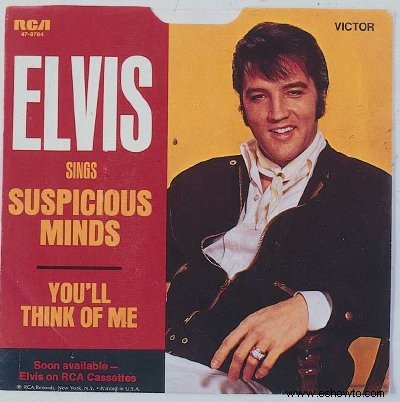
"Suspicious Minds," released in 1969, was Elvis Presley's final number-one hit.
After the two recording sessions at American Sound Studios in January and February of 1969, Elvis never recorded there again. Part of the reason was undoubtedly due to a clash over the rights to the songs that producer Chips Moman had suggested for Elvis, including "Suspicious Minds." RCA and Hill and Range, which oversaw Elvis' own publishing companies, wanted a substantial cut of the songs to which Moman owned the rights.
If Moman refused, there was pressure to let those songs slip through the sessions without being recorded. Some quality material was not recorded by Elvis because of the haggling over song rights by Hill and Range. Moman did not want to budge on "Suspicious Minds," and he threatened to cancel the session if Freddie Bienstock of Hill and Range did not back off. Fortunately, Elvis did record "Suspicious Minds," but the tension over song rights took its toll.
To learn more about Elvis Presley, see:
- Elvis Presley
- Elvis Presley Pictures
- Elvis Presley Quotes
- Elvis Presley Collectibles
- Elvis Presley Biography
Burning Love
The highlight of Elvis Presley's studio sessions in
Dennis Linde composed "Burning Love" especially for Elvis, and the songwriter played guitar on the recording. It was Linde who dubbed in the raucous guitar lick on the bridges of the song. He had occasionally served as a bass guitarist in Elvis' recording band during the 1970s.
"Burning Love" became a worldwide hit for Elvis in 1972, and it quickly charted on Billboard's Hot 100.
Peaking at number two, it just missed becoming a number-one record. Chuck Berry's "My Ding-a-Ling" kept "Burning Love" from hitting the top of the charts. The record was certified gold by the RIAA in October 1972, and it was certified platinum in March 1992.
Unfortunately, Elvis did not follow up on the excitement generated by the rocking "Burning Love." His next single release was a ballad, "Separate Ways," backed by Always on My Mind," which reached only number 20 on the Hot 100 chart. In addition, RCA buried "Burning Love" and its flip side, "It's a Matter of Time," on an album of old movie tracks creatively titled Burning Love and Hits from His Movies, Volume 2 . In terms of Elvis' career, this hit song seems to have gotten lost amidst bad marketing decisions.
To learn more about Elvis Presley, see:
- Elvis Presley
- Elvis Presley Pictures
- Elvis Presley Quotes
- Elvis Presley Collectibles
- Elvis Presley Biography
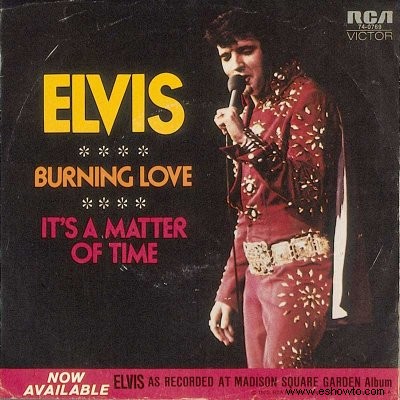
Elvis' raucous interpretation of "Burning Love" typifies his 1970s sound.
Elvis Presley's Best Cover Songs
"Hound Dog" was written by Jerry Leiber and Mike Stoller for blues singer Big Mama Thornton in 1953. The original lyrics contain a sexual connotation, and Thornton belted out her version in a gritty, slow blues style. Elvis' humorous interpretation was borrowed from Freddie Bell and the Bellboys.
Elvis recorded two versions of the Dave Bartholomew-Pearl King blues tune "One Night of Sin," which had been a hit for Smiley Lewis in 1956. On January 24, 1957, he recorded Lewis' version, and a month later he recorded the song as "One Night" using cleaned-up lyrics. In Lewis' risqué original, the singer is praying for "One night of sin," while in Elvis' more hopeful rendition, he is hoping for "One night with you..."
Tin Pan Alley songwriters Lou Handman and Roy Turk composed "Are You Lonesome Tonight?" ("To-night" on original record sleeve) in 1926, and it was originally recorded by Al Jolson the following year. Supposedly the only song Colonel Tom Parker ever urged Elvis to record, "Are You Lonesome Tonight?" was released by Elvis in 1960 and was nominated for three Grammys.
"Bridge Over Troubled Water" was composed by Paul Simon and Art Garfunkel and recorded by the folk-rock duo in 1970, becoming a number-one hit for them. Elvis recorded his version, which had a larger sound and a more dramatic vocal rendering, during the filming of Elvis -- That's the Way It Is.
Eddy Arnold, "the Tennessee Plowboy," had a hit record with the soft-sounding ballad "I Really Don't Want to Know" in 1954, just as Elvis was barn-storming across the South with his rockabilly style. Composed by Howard Barnes and Don Robertson, the song was released by Elvis in 1970 with another country tune, "There Goes My Everything," on the flipside. These songs represent Elvis' rediscovery of contemporary country music during the 1970s.
Originally arranged and recorded by country singer Mickey Newbury, "An American Trilogy" is a medley of "Dixie," "The Battle Hymn of the Republic," and "All My Trials." The integration of two Civil War songs (one a Southern anthem, the other a Northern anthem) with a traditional spiritual suggests the curiously Southern tradition of blending diverse cultural elements. Elvis' 1972 version of the piece offered an operatic interpretation that matched the breadth of the song's meaning.
Elvis sang James Taylor's 1970 composition "Steamroller Blues" in concert during the early 1970s, but his gritty rendition during the Aloha from Hawaii television special stopped the show. The version from the special was released as a single in April 1973.
In 1968, country singer Marty Robbins wrote "You Gave Me a Mountain," a wrenching ballad about life's hardships. Though pop star Frankie Laine was the first to release it, Elvis began singing the song in concert during the early 1970s and released it in 1973. Elvis' interpretation is generally considered autobiographical in that it paralleled his breakup with Priscilla Presley.
"My Way," an anthem of independence and individuality, was written by Paul Anka for Frank Sinatra and originally recorded by him in 1969. Elvis sang "My Way" on the Aloha from Hawaii television special and in concert during the 1970s. A recording of this song by Elvis was released shortly after he died, making it almost a biographical statement.
To learn more about Elvis Presley, see:
- Elvis Presley
- Elvis Presley Pictures
- Elvis Presley Quotes
- Elvis Presley Collectibles
- Elvis Presley Biography
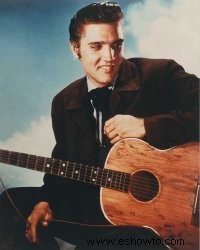
Many of Elvis' biggest hits were creative
interpretations of old standards.
Elvis Presley's Best Song Writers
The work of Elvis Presley's song writers is exceedingly famous; many of the composers themselves, however, are less well known. Below are biographies for some of Elvis' most notable song writers.
Otis Blackwell
Respected singer-songwriter Otis Blackwell composed many rock 'n' roll standards in the 1950s and 1960s. Born in Brooklyn in 1932, Blackwell grew up admiring country-western singer and actor Tex Ritter. Otis became a staff writer for Shalimar Music in early 1956 after he sold six songs to that company for $25 each, including "Don't Be Cruel." Blackwell had been standing in front of the Brill Building (home to rock 'n' roll music publishing) in New York City on Christmas Eve when an arranger asked him if he had any songs to sell. He then took Otis to meet Shalimar's owners, who purchased the songs and hired him after the holidays.
Elvis recorded ten Blackwell compositions including "Fever" (written with Eddie Cooley), “All Shook Up," "Paralyzed," and "Return to Sender" (rewritten with Winfield Scott). Among Blackwell's other rock 'n' roll classics are Jerry Lee Lewis' "Great Balls of Fire" and "Breathless." Blackwell sang on the demos of his songs for Elvis and Jerry Lee and imitated their styles, but Blackwell and Elvis never met.
Mac Davis
Dubbed the "the Song Painter" by Glen Campbell, Mac Davis is well known for composing songs that use concrete imagery to paint a picture or tell a story. In the 1970s, Davis teamed with Billy Strange, and Elvis recorded several Davis-Strange compositions. The pair provided Elvis with the theme song to Charro! , the tune "Nothingville" from the television special Elvis , a reflective ballad titled "Memories," and a couple of light pieces called "Clean Up Your Own Back Yard" and “A Little Less Conversation."
Alone, Davis wrote two of Elvis' biggest hits of the 1970s, the socially conscious "In the Ghetto" and the sentimental ballad "Don't Cry Daddy." During the late 1960s and 1970s, Davis' compositions were recorded by major artists, including Lou Rawls, Bobby Goldsboro, Glen Campbell, Kenny Rogers, Andy Williams, Sammy Davis, Jr., and Dolly Parton. Davis ventured into acting in the 1970s and costarred in a handful of major Hollywood movies, including North Dallas Forty and Cheaper to Keep Her .
Leiber And Stoller
Jerry Leiber and Mike Stoller adapted aspects of blues and R&B when writing for rock 'n' roll performers. Their integration of these musical genres in the 1950s expanded the commercial possibilities of rock 'n' roll. The pair met in Los Angeles in 1950 when they were just 17 years old. Stoller the musician and Leiber the songwriter found they shared an interest in blues and R&B, so they spent the summer writing songs in those styles.
Sill, sales manager for Modem Records, took them under his wing and introduced them to performers and industry reps. Despite their youth, the pair fared well because the prominent Tin Pan Alley songwriters of the day thought rock 'n' roll was beneath them. Leiber and Stoller are noted for structuring their songs like playlets. That is, they tell a story -- usually with wit or satire -- within the three-minute length of a popular song. Elvis recorded about two dozen Leiber and Stoller tunes, including "Hound Dog" and "Jailhouse Rock."
Doc Pomus and Mort Shuman
Brooklyn-born Doc Pomus and native New Yorker Mort Shuman teamed to write 15 songs for Elvis, including some that were used for his movie soundtracks. The unforgettable title song for Viva Las Vegas was composed by Pomus and Shuman especially for the film. Other movie songs included earlier Pomus-Shuman compositions that were then recycled for the soundtracks. Pomus cowrote a few other soundtrack tunes with other songwriters, including "Girl Happy," "I Feel That I've Known You Forever," and "She's Not You."
The team's best work was for Elvis' nonsoundtrack recordings, including the million-selling "Little Sister." Other significant Pomus-Shuman compositions include "Surrender,” based on the Italian ballad "Come Back to Sorrento," and "Suspicion." Pomus and Shuman also penned several rock classics for other artists, including "This Magic Moment" and "Save the Last Dance for Me" by the Drifters and "A Teenager in Love" by Dion and the Belmonts.
Jerry Reed
Born in Atlanta, Georgia, on March 20, 1937, country singer-songwriter Jerry Reed Hubbard composed four songs recorded by Elvis. Though this is only a handful in comparison to other songwriters who wrote for Elvis, two of the tunes included "Guitar Man" and "U.S. Male." These songs were recorded just prior to the surge of creativity generated by the television special Elvis . The songs represented a move away from the soundtrack recordings and toward better-quality material with a contemporary feel.
Reed also played guitar for Elvis on "Guitar Man." Reed was one of several Southern musicians who had been influenced by Elvis and later ended up working with him. In 1967, Reed recorded "Tupelo Mississippi Flash," an Elvis novelty record that was a comic tribute to his idol. Reed's career as a performer accelerated in the 1970s. He profited from his rowdy good-old-boy image when a vogue for things Southern hit Hollywood. He costarred with Burt Reynolds in four films, including the popular Smokey and the Bandit.
Ben Weisman
Born in 1921 in Providence, Rhode Island, Ben Weisman wrote or cowrote more than 50 songs for Elvis -- more than any other songwriter. Weisman began his prolific association with Elvis with "First in Line," which was recorded in 1956. He was often teamed with Fred Wise, but he also composed with Aaron Schroeder and Randy Starr.
Many of Weisman's compositions were written for Elvis' movie soundtracks, so they were intended to fit into the story-line or advance the plot. Most were in the smooth, pop-flavored style that defined Elvis' soundtrack recordings. Within those limitations, Weisman sometimes came up with some memorable runes. Some of his best include "Crawfish" from King Creole , the title tune from Follow That Dream , "Rock-a-Hula Baby" from Blue Hawaii , "I Slipped, I Stumbled, I Fell" from Wild in the Country , and "Got a Lot o' Livin' to Do" from Loving You . In his later career, Weisman had a recurring role on the CBS soap opera The Young and the Restless as a pianist in the Club Allegro.
To learn more about Elvis Presley, see:
- Elvis Presley
- Elvis Presley Pictures
- Elvis Presley Quotes
- Elvis Presley Collectibles
- Elvis Presley Biography
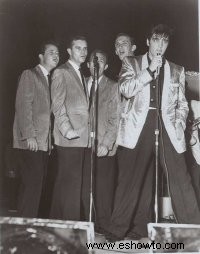
Elvis' songwriters worked behind the scenes
to help create memorable performances.
List of Elvis Songs A - F
Elvis Presley recorded well over a thousand songs throughout the course of his career. The titles range from splashy summer movie themes to heartfelt love ballads to old blues tunes. The following pages display Elvis' complete recordings in alphabetical order. Below are the titles A through F.(Alla En) El Rancho Grande
(It's A) Long, Lonely Highway
(Let Me Be Your) Teddy Bear
(Marie's the Name Of) His Latest Flame
(Now and Then There's) A Fool Such as I
(Such An) Easy Question
(That's What You Get) For Lovin' Me
(There'll Be) Peace in the Valley (For Me)
(There's) No Room to Rhumba in a Sports Car
(You're So Square) Baby I Don't Care
(You're the) Devil in Disguise
A Big Hunk O' Love
A Boy Like Me, A Girl Like You
A Cane and a High Starched Collar
A Dog's Life
A Fan
A Fool Such as I
A House That Has Everything
A Hundred Years From Now
A Little Less Conversation
A Little Bit of Green
A Matter of Time
A Mess of Blues
A Thing Called Love
A Woman's Love (Thrill of Your Love)
A World of Our Own
Adam and Evil
Adeste Fideles
After Loving You
Ain't That Lovin' You Baby
All Around the World
All I Needed Was the Rain
All Right, Okay, You Win
All Shook Up
All That I Am
Almost
Almost Always True
Almost in Love
Aloha Oe
Also Sprach Zarathustra
Always on My Mind
Am I Ready
Amazing Grace
America the Beautiful
America
American Trilogy
An Evening Party
An Evening Prayer
An Old Christmas Card
And I Love You So
And the Grass Won't Pay No Mind
Angel
Animal Instinct
Any Day Now
Any Way You Want Me (That's How I Will Be)
Anyone (Could Fall in Love With You)
Anyplace is Paradise
Anything That's a Part of You
Are You Lonesome Tonight?
Are You Sincere
As Long as I Have You
As We Travel Along the Jericho Road
Ask Me
At the End of the Road
Aura Lee (Love Me Tender)
Away in a Manger
Baby Face
Baby I Don't Care
Baby Let's Play House
Baby, If You'll Give Me All of Your Love
Baby, What You Want Me to Do
Bama Lama Bama Loo
Barefoot Ballad
Beach Boy Blues
Beach Shack
Because of Love
Beginner's Luck
Beyond the Bend
Beyond the Reef
Big Boots
Big Boss Man
Big Love, Big Heartache
Bitter They Are, Harder They Fall
Black Bottom Stomp
Black Star
Blessed Jesus (Hold My Hand)
Blind Date
Blowin' in the Wind
Blue Christmas
Blue Eyes Cryin' in the Rain
Blue Hawaii
Blue Moon of Kentucky
Blue Moon
Blue River
Blue Suede Shoes
Blueberry Hill
Blues Boogie
Bo Diddley
Born to Rock
Bosom of Abraham
Bossa Nova Baby
Bridge Over Troubled Water
Bringing It Back
Britches
Brown Eyed Handsome Man
Burning Love
By and By
By the Light of the Silvery Moon
C'mon Everybody
C.C. Rider
Can't Believe You Wanna Leave
Can't Help Fallin' in Love
Care if the Sun Don't Shine
Carny Town
Catchin' on Fast
Cattle Call
Change of Habit
Charro!
Chesay
Cindy, Cindy
City by Night
Clambake
Clean Up Your Own Backyard
Come Along
Come What May
Concert Fever
Confidence
Cotton Candy Land
Cotton Fields
Could I Fall in Love
Crawfish
Crazy Arms
Cross My Heart and Hope to Die
Crying in the Chapel
Dainty Little Moonbeams
Danny Boy
Danny
Dark Moon
Darling Wait for Me
Datin'
Deck the Halls
Devil in Disguise
Didja' Ever
Dirty, Dirty Feeling
Dixieland Rock
Do Not Disturb
Do the Clam
Do the Vega
Do You Enjoy Your Work
Do You Have Any Time to Read
Do You Know Who I Am?
Do You Like to Work
Do You Like Yourself
Do You Think You've Changed Much
Doin' the Best I Can
Dominic
Don't Ask Me Why
Don't Be Cruel
Don't Cry Daddy
Don't Forbid Me
Don't Leave Me Now
Don't Think Twice, It's All Right
Don't
Doncha' Think It's Time
Double Trouble
Down by the Riverside
Down in the Alley
Drums of the Islands
Early Mornin' Rain
Earth Angel
Earth Boy
Easy Come, Easy Go
Easy Question
Echoes of Love
Edge of Reality
El Paso
El Toro
End of the Road
End Theme
Everybody Come Aboard
Everyday
Faded Love
Fairytale
Faithful and True
Fame and Fortune
Farther Along
Fever
Fin in Acapulco
Find Out What's Happening
Finders Keepers, Losers Weepers
Fire Down Below
First in Line
Five Sleepyheads
Flaming Star
Flip Flop and Fly
Follow That Dream
Fool, Fool, Fool
Fools Fall in Love
Fools Rush In
For Ol' Times Sake
For the Good Times
For the Heart
For the Millionth and Last Time
Forget Me Never
Fort Lauderdale Chamber of Commerce
Fountain of LoveFrankfort SpecialFrankie and JohnnyFree the LadyFroggie Went A-Courtin'From a Jack to a KingFrom Graceland to the Promised Land
Fun in AcapulcoFunny How Time Slips Away
To learn more about Elvis Presley, see:
- Elvis Presley
- Elvis Presley Pictures
- Elvis Presley Quotes
- Elvis Presley Collectables
- Elvis Presley Biography
List of Elvis Songs G - I
The chart below displays the titles G - I of Elvis Presley's recorded songs.
SOLDADO AMERICANO. Blues
G.I. Rock 'N' Roll
Gentle on My Mind
Gently
Girl Happy
Girl of Mine
Girls! Girls! Girls!
Give Me the Right
Go East Young Man
God Rest Ye Merry Gentlemen
Goin' Home
Going Home to the USA
Golden Coins Gonna Get Back Home Somehow
Good Golly Miss Molly
Good King Wenceslas
Good Luck Charm
Good Rockin' Tonight
Good Time Charlie's Got the Blues
Got a Lot O' Livin' to Do!
Got My Mojo Working
Green, Green Grass of Home
Guadalajara
Guitar Man
Hands Off
Happy Ending
Harbor Lights
Hard Headed Woman
Hard Knocks
Hard Luck
Harem Holiday
Have a Happy
Have I Told You Lately That I Love You
Hawaiian Sunset
Hawaiian Wedding Song
He Is My Everything
He Knows Just What I Need
He Touched Me
He'll Have to Go
He's Your Uncle, Not Your Dad
Heart of Rome
Heartbeat
Heartbreak Hotel
Hearts of Stone
Help Me Make It Through the Night
Help Me
He
Here Comes Santa Claus
Hey Jude
Hey Little Girl
Hey, Hey, Hey
Hi-Heel Sneakers
Hide Thou Me
His Hand in Mine
His Latest Flame
Holly Leaves and Christmas Trees
Home Is Where the Heart Is
Honey, Honey, Honey, Treat Me Nice
Hot Dog
Hound Dog
House of Sand
How Can You Lose What You Never Had How Do You Relax
How Do You Think I Feel
How Great Thou Art
How Long Can You Give Love
How the Web Was Woven
How Would You Like to Be Big Boss Man
How Would You Like to Be?
How's the World Treating You
Hurt
I Asked the Lord
I Beg of You
I Believe in the Man in the Sky
I Believe
I Can Help
I Can't Help It (If I'm Still in Love With You)
I Can't Stop Loving You
I Didn't Make It on Playing Guitar
I Don't Care if the Sun Don't Shine
I Don't Wanna Be Tied
I Don't Want To
I Feel So Bad
I Feel That I've Known You Forever
I Forgot to Remember to Forget
I Got a Feelin' in My Body
I Got a Sweetie
I Got a Woman
I Got Lucky
I Got Stung
I Gotta Know
I Hear a Sweet Voice Calling
I Just Can't Help Believin'
I Just Can't Make It by Myself
I Love Only One Girl
I Love You Because
I Met Her Today
I Miss You
I Need Somebody to Lean On
I Need You So
I Need Your Love Tonight
I Really Don't Want to Know
I Shall Be Released
I Slipped, I Stumbled, I Fell
I Think I'm Gon na Like It Here
I Tried
I Understand (Just How You Feel)
I Want to Be Free
I Want You With Me
I Want You, I Need You, I Love You
I Want You With Me
I Was Born About 10,000 Years Ago
I Was the One
I Washed My Hands in Muddy Water
I Will be Home Again
I Will Be True
I'll Be Back
I'll Be Home Again
I'll Be Home for Christmas
I'll Be Home on Christmas Day
I'll Be There
I'll Hold You in My Heart (Till I Can Hold You in My Arms)
I'll Never Fall in Love Again
I'll Never Know
I'll Never Let You Go
I'll Never Stand in Your Way
I'll Remember You
I'll Take Love
I'll Take You Home Again, Kathleen
I'm a Roustabout
I'm Beginning to Forget You
I'm Comin' Home
I'm Counting on You
I'm Falling in Love Tonight
I'm Gonna Bid My Blues Goodbye
I'm Gonna Sit Right Down and Cry
I'm Gonna Walk Dem Golden Stairs
I'm Le avin'
I'm Left, You're Right, She's Gone
I'm Movin' On
I'm Not the Marrying Kind
I'm So Lonesome I Could Cry
I'm With a Crowd But So Alone
I'm Yours
I've Been Blue
I've Got a Thing About You Baby
I've Got a Woman
I've Got Confidence
I've Got to Find My Baby
I've Lost You
I, John
If Every Day was Like Christmas Day
If I Can Dream
If I Get Home on Christmas Day
If I Loved You
If I were You
If I'm a Fool
If That Isn't Love
If the Lord Wasn't Walking by My Side
If We Never Meet Again
If You Don't Come Back
If You Had a Child
If You Love Me (Let Me Know)
If You Talk in Your Sleep
If You Think I Don't Need You
In My Father's House
In My Way
In the Garden
In the Ghetto
In Your Arms
Indescribably BlueInherit the Wind Is It So Strange Island of Love It Ain't No Big Thing (But It's Growing) It Came Upon a Midnight Clear It Feels So RightIt Hurts Me It Is No Secret It Is So Strange It Keeps Right on A-Hurtin' It Won't Be Long It Won't Seem Like Christmas (Without You)It Wouldn't Be the Same Without You It's a Matter of Time It's a Sin It's a Wonderful World It's Carnival Time It's Diff'rent Now It's Easy for You It's Impossible It's Just a Matter of TimeIt's Midnight It's No Fun Being Lonely It's Now or Never (O Sole Mio) It's Only Love It's Over It's Still Here It's Your Baby, You Rock It Ito EatsTo learn more about Elvis Presley, see:
- Elvis Presley
- Elvis Presley Pictures
- Elvis Presley Quotes
- Elvis Presley Collectibles
- Elvis Presley Biography
List of Elvis Songs J - P
The chart below displays the titles J - P of Elvis Presley's recorded songs.
Jack and Jill
Jailhouse Rock
Jamabalaya
Jam
Jaycee's Speech
Jenny Jenny
Jerry's Boogie
Jesus Walked That Lonesome Valley
Jingle Bells
Johnny B. Goode
Joshua Fit the Battle
Joy to the World
Judy
Just a Little Bit
Just a Little Talk With Jesus
Just Because
Just Call Me Lonesome
Just for Old Times Sake
Just Pretend
Just Tell Her Jim Said Hello
Keep a Knockin'
Keeper of the Key
Kentucky Rain
King Creole
King of the Whole Wide World
Kismet
Kiss Me Once
Kiss Me Quick
Kissin' Cousins
Known Only to Him
Ku-U-I-Po (Hawaiian Sweetheart)
Lady Madonna
Lawdy Miss Clawdy
Lead Me, Guide Me
Learning the Game
Let It Be Me (Je T'Appartiens)
Let It Snow! ¡Deja que nieve! ¡Deja que nieve!
Let Me Be There
Let Me
Let Us Pray
Let Yourself Go
Let's Be Friends
Let's Forget About the Stars
Life
Like a Baby
Listen to Me
Little Cabin on the Hill
Little Darlin'
Little Egypt
Little Sister
Lonely Man
Lonely Soldier Boy
Lonesome Cowboy
Long Black Limousine
Long Legged Girl
Long Lonely Highway
Long Tall Sally
Look Out Broadway
Louisiana Hayride Theme
Love Coming Down
Love Letters
Love Me Tender
Love Me, Love the Life I Lead
Love Me
Love Song of the Year
Love's Made a Fool of You
Lover Doll
Lovin' Arms
Loving You
Lucille
Make Believe
Make Me Know It
Make the World Go Away
Mama Liked the Roses
Mama
Mansion Over the Hilltop
Marguerita
Mary in the Morning
Mary Lou Brown
Maybe Baby
Maybelline
Mean Woman Blues
Meanest Girl in Town
Memories
Memphis Tennessee
Men With Broken Hearts
Merry Christmas, Baby
Mess or Blues
Message from Elvis
Mexico Marguerita
Mexico
Midnight Shift
Milk Cow Blues
Milkman
Milky White Way
Mine
Miracle of the Rosary
Mirage
Miss Ann
Mona Lisa
Money Honey
Moody Blue
Moondreams
Moonlight Swim
Mr. Songman
My Babe
My Baby Left Me
My Baby's Gone
My Boy
My Desert Serenade
My Happiness
My Heart Cries for You
My Last Blues
My Little Friend
My Way
My Wish Came True
Mystery Train
Never Again
Never Been to Spain
Never Ending
Never Say Yes
New Orleans
New York is Closed Tonight
Nick Adams
Night Life
Night Rider
No More
Nothingville
O Come All Ye Faithful
O Holy Night
O Little Town of Bethelehem
Oh Boy
Oh Happy Day
Oh, How I Love Jesus
Old MacDonald
Old Shep
On a Snowy Christmas Night
On the Jericho Road
On the Road to Safety
On Top of Old Smokey
Once is Enough
One Boy, Two Little Girls
One Broken Heart for Sale
One is Enough
One Night of Sin
One Night
One Track Heart
One-Sided Love Affair
Only Believe
Only the Strong Surviv e
Ooh My Soul
Out of Sight, Out of Mind
Padre
Paradise, Hawaiian Style
Paradise
Paralyzed
Parker
Party
Patch It Up
Peace in the Valley
Peggy Sue
Peter Gunn Theme
Petunia, the Gardener's Daughter
Pieces of My Life
Plantation Rock
Playing for Keeps
Please Don't Drag That String Around
Please Don't Stop Loving Me
Pledging My Love
Pocketful of Rainbows
Poison Ivy League
Poor Boy
Poor Man's Gold
Pork Salad Annie
Power of My Love
Private Elvis
Promised Land
Proud Mary
Puppet on a String
Put the Blame on Me
Put Your Hand in the Hand
To learn more about Elvis Presley, see:
- Elvis Presley
- Elvis Presley Pictures
- Elvis Presley Quotes
- Elvis Presley Collectibles
- Elvis Presley Biography
List of Elvis Songs Q - T
The chart below displays the titles Q - T of Elvis Presley's recorded songs.
Queen of the Night
Queenie Wahine's Papaya
Rags to Riches
Raining in My Heart
Raised on Rock
Reach Out to Jesus
Ready Teddy
Recollections
Reconsider Baby
Relax
Release Me
Reminiscing
Return to Sender
Riding the Rainbow
Rip It Up
Rock-A-Bye Rock
Rock-A-Hula Baby
Roustabout
Rubberneckin'
Run On
Runaway
San Antonio Rose
Sand Castles
Santa Bring My Baby Back
Santa Claus is Back in Town
Santa's Party
Saved
Scratch My Back
See See Rider
Seeing is Believing
Send Me Some Lovin'
Sentimental Me
Separate Ways
Shake a Hand
Shake Rattle &Roll
Shake That Tambourine
She Thinks I Still Care
She Wears My Ring
She's a Machine
She's Got It
She's Not You
Shoppin' Around
Shout It Out
Show Me Thy Ways, O Lord
Sick, Sober &Sorry
Signs of the Zodiac
Silent Night
Silver Bells
Sing You Children
Singing Tree
Slicin' Sand
Slippin' and Slidin'
Slowly But Surely
Smokey Mountain Boy
Smokey Mountain Way
Smorgasbord
Snowbird
So Close, Yet So Far
So Glad You're Mine
So High
Softly and Tenderly
Softly, As I Leave You
Soldier Boy
Solitaire
Somebody Bigger Than You and I
Something Blue
Something
Sometimes I Feel Like a Motherless Child
Song of the Shrimp
Sound Advice
Sowbird
Spanish Eyes
Speedway
Spinout
Spring Fever
Stand by Me
Startin' Tonight
Starting Today
Stay Away Joe
Stay Away
Steadfast, Loyal and True
Steamroller Blues
Steppin' Out of Line
Stop Where You Are
Stop, Look and Listen
Stranger in My Own Home Town
Stranger in the Crowd
Stuck on You
Such a Night
Suicide
Summer Kisses, Winter Tears
Summertime Has Passed and Gone
Suppose
Surrender
Susan When She Tried
Suspicion
Suspicious Minds
Sweet America
Sweet Angeline
Sweet Caroline
Sweetheart You Done Me Wrong
Swing Down Sweet Chariot
Sylvia
Take Good Care of Her
Take Me to the Fair
Take My Hand, Precious Lord
Talk About the Good Times
Teaser
Teddy Bear
Tell Me Why
Tell Us About Gladys
Tender Feeling
Tennessee Waltz
Thanks to the Rolling Sea
That's All Right Mama
That's Alright
That's My Desire
That's Someone You Never Forget
That's What They Say
That's When Your Heartaches Begin
The Bullfighter Was a Lady
The Christmas Song
The Climb
The Eyes of Texas
The Fair is Moving On
The First Noel
The First Time Ever I Saw Her
The First Time I Ever Saw Your Face
The Fool
The Girl Can't Help It
The Girl I Adore
The Girl I Never Loved
The Girl Next Door Went A'Walking
The Girl of My Best Friend
The Impossible Dream
The Lady Loves Me
The Last Farewell
The Lord's Prayer
The Love Machine
The Next Step is Love
The Sound of Your Cry
The Sweet Inspirations
The Thrill of Your Love
The Truth About Me
The Twelfth of Never
The Walls Have Ears
The Whiffenpoof Song
The Wonderful World of Christmas
The Wonder of You
The Yellow Rose of Texas/The Eyes of Texas
There Ain't Nothing Like a Song
There Goes My Everything
There Is No God But God
There Is So Much World to See
There's a Brand New Day on the Horizon
There's a Honky Tonk Angel
There's Always Me
There's Gold in the Mountains
There's Good Rockin' Tonight
There's No Place Like Home
They Remind Me Too Much of You
Thinking About You
This Is Living
This Is My Heaven
This Is Our Dance
This Is the Story
This Time/I Can't Stop Loving Your
Three Corn Patches
Thrill of Your Love
Tiger Man
Today, Tomorrow and Forever
Tomorrow is a Long Time
Tomorrow Never Comes
Tomorrow Night
Tonight Is So Right For Love
Tonight's All Right for Love
Too Much Monkey Business
Too Much
Treat Me Nice
Trouble
True Fine Mama
True Love Travels on a Gravel Road
True Love Ways
True Love
Tryin' to Get to You
Tumblin' Tumbleweeds
Turn Your Eyes Upon Jesus
Tutti Frutti
Tweedle Dee Tweedle Dum
Twenty Days and Twenty Nights
To learn more about Elvis Presley, see:
- Elvis Presley
- Elvis Presley Pictures
- Elvis Presley Quotes
- Elvis Presley Collectibles
- Elvis Presley Biography
List of Elvis Songs U - Z
The chart below displays the titles U - Z of Elvis Presley's recorded songs.
U.S. Male
Unchained Melody
Until It's Time for You to Go
Up Above My Head/I Found That Light
Vino, Dinero y Amor
Violet
Viva Las Vegas
Walk a Mile in My Shoes
Walk That Lonesome Valley
Was It by Accident
Was the One
Way Down
We Call on Him
We Can Make the Morning
We Wish You a Merry Christmas
We'll Be Together
We're Coming in Loaded
We're Gonna Move
Wear My Ring Around Your Neck
Wearin' That Loved on Look
Welcome to My World
Western Union
What a Wonderful Life
What Do You Think
What Every Woman Lives For
What Now My Love
What Now, What Next, Where To?
What to Do
What'd I Say
What's She Really Like
Wheels on My Heels
When God Dips His Love in My Heart
When I'm Over You
When It Rains, It Really Pours
When It's My Time
When My Blue Moon Turns to Gold Again
When the Saints Go Marchin' In
When the Snow Is on the Roses
Where Can I Go But to the Lord
Where Did They Go, Lord
Where Do I Go From Here?
Where Do You Come From
Where No One Stands Alone
Where Would I Go
Whistling Tune
White Christmas
Who Am I?
Who Are You
Who Needs Money?
Whole Lotta Shakin' Going On
Why Can't They Leave Him Alone
Why Me Lord?
Wife Number 99
Wild in the Country
Winter Wonderland
Wisdom of the Ages
Witchcraft
Without a Song
Without Him
Without Love
Wolf Call
Woman Without Love
Wonderful World
Wooden Heart
Words of Love
Words
Working on the Building
Would You Do Anything Different
Write to Me from Naples
Yellow Rose of Texas
Yesterday
Yoga Is as Yoga Does
You Asked Me To
You Belong to My Heart
You Better Run
You Can't Say No in Acapulco
You Don't Have to Say You Love Me
You Don't Know Me
You Gave Me a Mountain
You Gotta Stop
You'll Be Gone
You'll Never Walk Alone
You'll Think of Me
You're a Heartbreaker
You're in the Army Now
You're the Boss
You're the Only Star (In My Blue Heaven)
You're the Reason I'm Living
You've Lost That Lovin' Feelin'
Young and Beautiful
Young Dreams
Your Cheatin' Heart
To learn more about Elvis Presley, see:
- Elvis Presley
- Elvis Presley Pictures
- Elvis Presley Quotes
- Elvis Presley Collectibles
- Elvis Presley Biography

